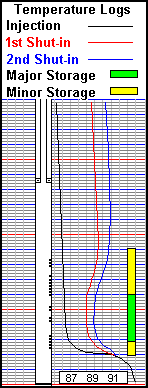

Temperature logs are crucial to determining the flow characteristics of a well, both inside and outside the casing. While temperature logs are one of the oldest forms of logging, there are no other logs run in the oil industry today that match its depth of investigation into the formation.
Dynamic temperature profiles (producing / injection) tend to reflect near wellbore events. Fluid entries, exits, velocity changes, gas expansion, and compression are some of the events clearly seen under dynamic conditions. However, you typically only see the very bottom of the event due to the moving fluid masking the top of the event.
Shut-in temperature profiles will show the tops of events noted on the dynamic passes. A difference in temperature decay will be seen at the tops of active areas by stopping the fluid movement in the wellbore. IMPORTANT NOTE: Fluid status in the wellbore must be determined while the shut-in passes are being run. A slight crossflow or zone swapping in the wellbore will have a substantial effect on the shut-in temperatures. You cannot make an accurate interpretation unless you know the well's fluid status. See the crossflow page for information on determining fluid movement during shut-in passes.
Another important aspect of the shut-in temperature is the comparison to the dynamic temperature, especially at the bottom of the well. If you change the temperature at the bottom of the logging pass by shutting in the well, you have modified the flow at that point in the well. Thus, the well is in communication with a zone below the logged depth. This is true whether the communication is inside of outside the wellbore. Other logging methods are used to determine the communications path.
Many people have a difficult time with temperature interpretation and we do not have room in this segment to begin a serious discussion on the subject. However, I would like to leave you with this one point. Don't fall into the trap of looking at one sensor for a particular purpose. One must consider all the data acquired during the log for an accurate interpretation. In the above paragraph we discuss the change in temperature between dynamic and shut-in well conditions, at the bottom of the logging pass. The opposite result would be that we created no temperature difference by shutting in the well. This would normally indicate no communication below the logged depth. There was no fluid movement at that point in the well while open and there was no movement when we shut-in the well, right? Not necessarily. Crossflow checks might indicate a slight flow up from below while the well is shut-in. If this rate matches the rate while the well is open, there will be no difference in temperature. Assume nothing, check all your data.
Look for temperature interpretation subjects at our site in the near future.
Injection Profile Page
Cardinal Welcome Page
